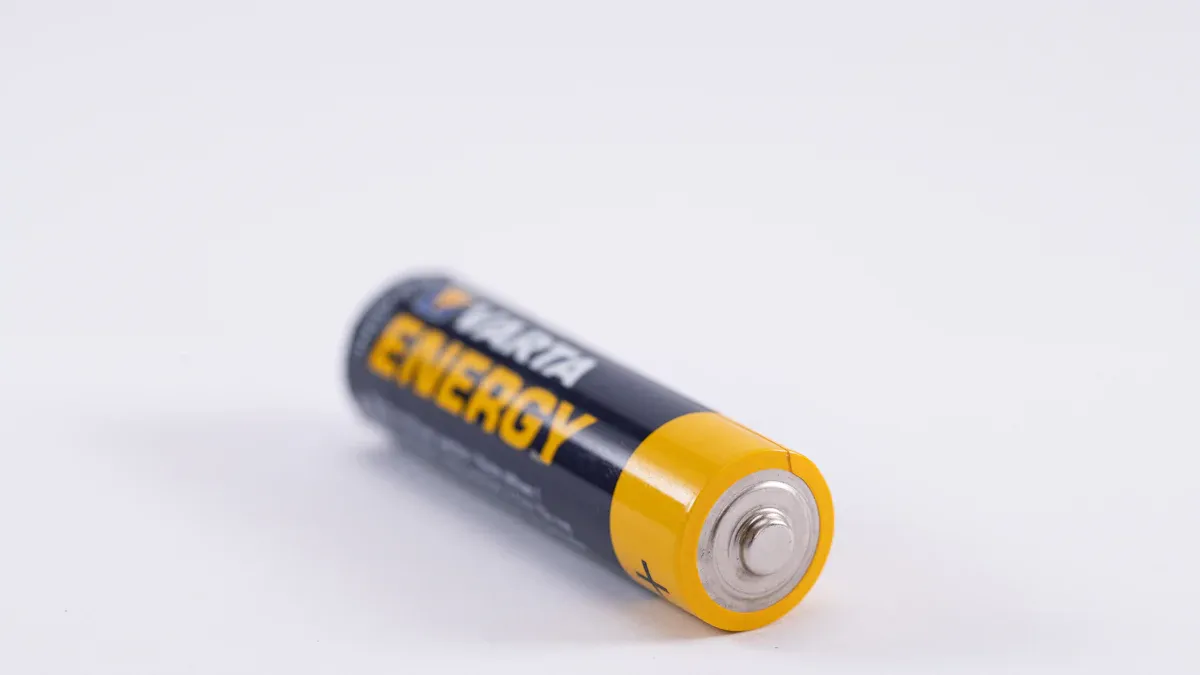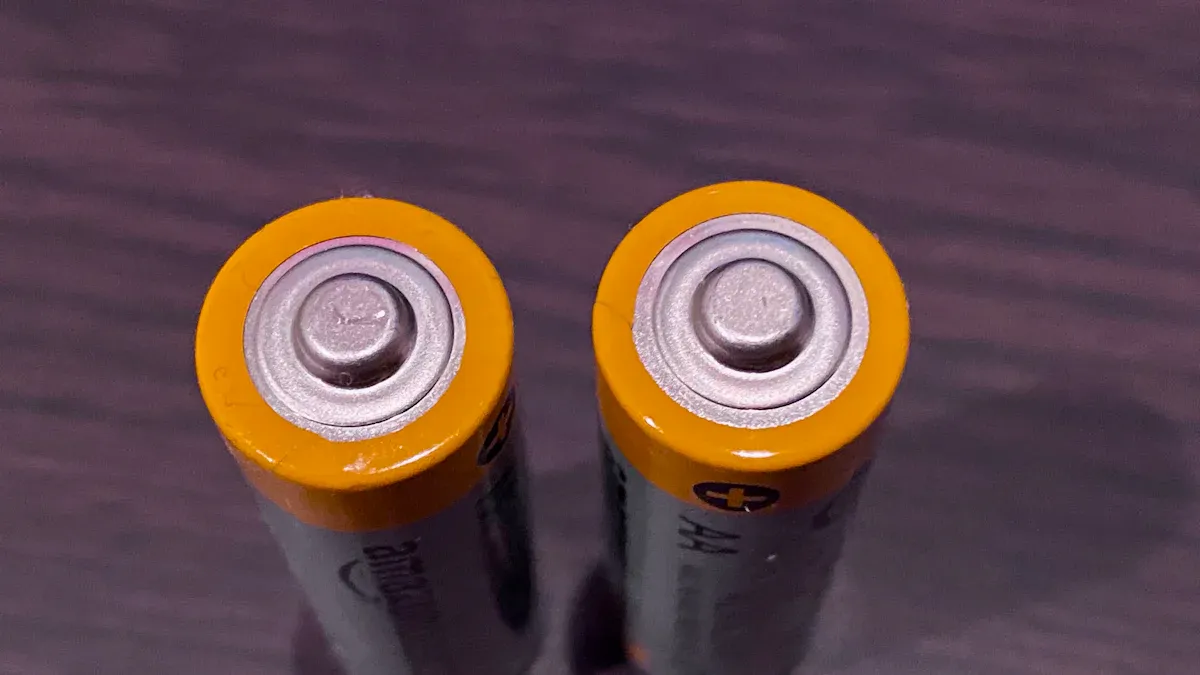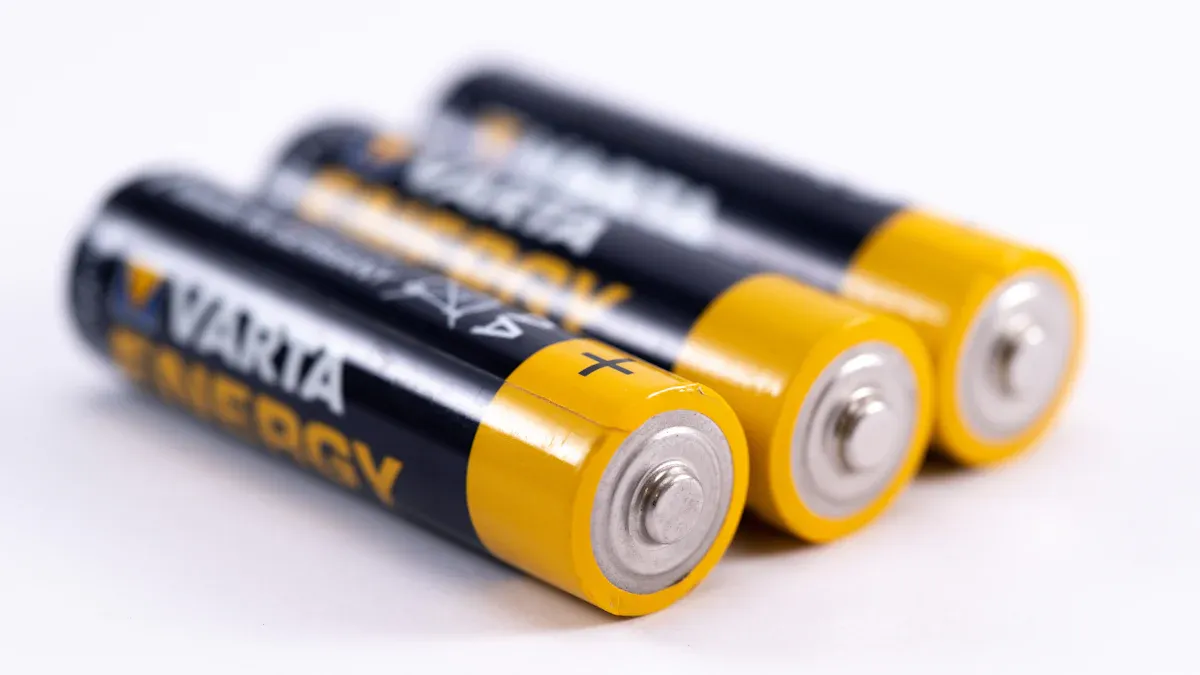
Rechargeable alkaline batteries, including the wholesale 1.5v rechargeable AA alkaline battery fo, deliver exceptional efficiency and reliability for powering industrial devices. These alkaline batteries are designed to provide outstanding performance and durability, ensuring seamless operations even in the most demanding environments. With a focus on sustainability, they help reduce waste and promote eco-friendly practices, making them a versatile and cost-effective solution for various industrial applications.
Key Takeaways
- Rechargeable alkaline batteries give steady power and last long. They are great for industrial use.
- Picking eco-friendly batteries lowers harm to the environment. It also helps meet sustainability goals in your work.
- Check how well batteries work and their price to find the best one for your industrial needs.
Key Criteria for Selecting Rechargeable Alkaline Batteries
Performance and Power Output
Industrial applications demand batteries with consistent power delivery and high energy density. Rechargeable alkaline batteries excel in this area, offering reliable performance across various devices. Their ability to maintain stable voltage levels ensures uninterrupted operations, even under heavy loads. These batteries are ideal for equipment requiring sustained energy output, such as medical devices and manufacturing tools.
Durability and Lifespan
Durability plays a crucial role in industrial settings. Rechargeable alkaline batteries are designed to withstand rigorous use, providing extended service life and multiple recharge cycles. Their robust construction minimizes wear and tear, ensuring long-term reliability. This durability reduces the frequency of replacements, saving time and resources for industries.
Eco-Friendliness and Sustainability
Rechargeable alkaline batteries contribute significantly to environmental sustainability.
- They lack harmful substances like mercury, lead, and cadmium, ensuring safe disposal.
- Certifications from UL and CE validate their eco-friendly design and adherence to strict environmental standards.
- Studies reveal that rechargeable batteries have up to 32 times less environmental impact than disposable ones, considering production, transport, and disposal.
- Manufacturers prioritize recyclable packaging and efficient production processes to minimize waste.
These features make rechargeable alkaline batteries a sustainable choice for industries aiming to reduce their carbon footprint.
Cost-Effectiveness and Value for Money
Rechargeable alkaline batteries offer excellent value for money due to their extended lifespan and reduced replacement frequency. A cost analysis highlights their economic benefits:
| Battery Type | Price Elasticity Estimate | Key Characteristics |
|---|---|---|
| Dry Cell Batteries | -0.5 | Inelastic, larger proportion of end-product value, potential for substitution with other battery types. |
| Carbon-Zinc Batteries | -0.8 to -1.2 | Shortest useful life, high visibility of price to consumers, frequent replacement needed. |
| Nickel-Cadmium | N/A | Rechargeable, longer service life, but generally smaller power reserve than alkaline batteries. |
| Alkaline Batteries | N/A | More expensive than carbon-zinc, longer service life, potential for substitution with other types. |
Rechargeable alkaline batteries stand out for their balance of cost and performance, making them a preferred choice for industrial applications.
Detailed Reviews of the Top 10 Rechargeable Alkaline Batteries

Panasonic Pro Rechargeable Battery: Features, Pros, Cons, and Ideal Use Cases
Panasonic Pro Rechargeable Battery delivers exceptional performance for industrial applications. Its high energy density ensures consistent power output, making it ideal for devices requiring sustained energy. The battery features advanced alkaline technology, which enhances its lifespan and recharge cycles.
Features:
- High energy density for reliable power delivery.
- Advanced alkaline technology for extended lifespan.
- Compatible with a wide range of industrial devices.
Pros:
- Long-lasting performance.
- Minimal self-discharge rate.
- Suitable for high-drain equipment.
Cons:
- Slightly higher upfront cost compared to standard alkaline batteries.
Ideal Use Cases:
Panasonic Pro Rechargeable Battery is perfect for medical devices, manufacturing tools, and industrial sensors requiring consistent and reliable power.
EBL NiMH AA 2,800 mAh: Features, Pros, Cons, and Ideal Use Cases
EBL NiMH AA 2,800 mAh stands out for its high capacity and durability. It offers up to 1,200 recharge cycles, making it a cost-effective choice for industries. Its eco-friendly design aligns with sustainability goals.
Features:
- 2,800 mAh capacity for extended runtime.
- Up to 1,200 recharge cycles.
- Environmentally friendly materials.
Pros:
- High capacity for prolonged use.
- Durable construction.
- Reduced environmental impact.
Cons:
- Requires specific chargers for optimal performance.
Ideal Use Cases:
This battery is ideal for industrial lighting systems, portable tools, and communication devices.
HiQuick NiMH AA 2,800 mAh: Features, Pros, Cons, and Ideal Use Cases
HiQuick NiMH AA 2,800 mAh offers reliable performance and fast charging capabilities. Its robust design ensures durability in demanding environments.
Features:
- Fast charging technology.
- 2,800 mAh capacity for extended use.
- Low self-discharge rate.
Pros:
- Quick recharge time.
- Long-lasting power.
- Compatible with various industrial devices.
Cons:
- Limited availability in some regions.
Ideal Use Cases:
HiQuick batteries are suitable for emergency equipment, industrial cameras, and handheld devices.
Tenergy Premium Pro: Features, Pros, Cons, and Ideal Use Cases
Tenergy Premium Pro combines high performance with affordability. Its advanced alkaline composition ensures consistent power delivery and long service life.
Features:
- Advanced alkaline composition.
- High energy density.
- Affordable pricing.
Pros:
- Reliable performance.
- Cost-effective solution.
- Wide compatibility.
Cons:
- Slightly heavier than other options.
Ideal Use Cases:
This battery is ideal for industrial automation systems, medical devices, and manufacturing tools.
Duracell Optimum: Features, Pros, Cons, and Ideal Use Cases
Duracell Optimum offers premium performance and durability. Its innovative design maximizes energy efficiency, making it a top choice for industrial applications.
Features:
- Innovative energy-efficient design.
- Long-lasting power.
- Trusted brand reputation.
Pros:
- Superior performance.
- Extended lifespan.
- Widely available.
Cons:
- Higher price point.
Ideal Use Cases:
Duracell Optimum is perfect for high-drain devices, industrial sensors, and portable equipment.
ProCell Constant AA Long-Lasting Alkaline Batteries: Features, Pros, Cons, and Ideal Use Cases
ProCell Constant AA batteries deliver consistent power for demanding industrial environments. Their robust construction ensures reliability and longevity.
Features:
- Long-lasting alkaline technology.
- Consistent power output.
- Designed for industrial use.
Pros:
- Reliable performance.
- Durable construction.
- Cost-effective for bulk purchases.
Cons:
- Limited recharge cycles compared to NiMH batteries.
Ideal Use Cases:
These batteries are ideal for manufacturing tools, industrial lighting, and communication devices.
Amazon Basics Industrial AA Alkaline Batteries: Features, Pros, Cons, and Ideal Use Cases
Amazon Basics Industrial AA batteries offer affordability without compromising quality. Their reliable performance makes them a popular choice for various industries.
Features:
- Affordable pricing.
- Reliable alkaline technology.
- Wide compatibility.
Pros:
- Cost-effective solution.
- Consistent power delivery.
- Easy availability.
Cons:
- Shorter lifespan compared to premium brands.
Ideal Use Cases:
These batteries are suitable for industrial sensors, handheld devices, and emergency equipment.
everActive Pro Alkaline Series: Features, Pros, Cons, and Ideal Use Cases
everActive Pro Alkaline Series combines eco-friendly design with high performance. Its recyclable packaging and efficient production processes align with sustainability goals.
Features:
- Eco-friendly materials.
- High energy density.
- Recyclable packaging.
Pros:
- Environmentally friendly.
- Reliable performance.
- Durable construction.
Cons:
- Limited availability in some markets.
Ideal Use Cases:
This battery is ideal for industrial lighting systems, portable tools, and communication devices.
Energizer Industrial AA Alkaline Batteries: Features, Pros, Cons, and Ideal Use Cases
Energizer Industrial AA batteries deliver consistent power and durability. Their trusted brand reputation ensures reliability in demanding environments.
Features:
- Trusted brand reputation.
- Long-lasting alkaline technology.
- Consistent power output.
Pros:
- Reliable performance.
- Durable construction.
- Widely available.
Cons:
- Slightly higher price point.
Ideal Use Cases:
These batteries are perfect for manufacturing tools, industrial sensors, and portable equipment.
Johnson Rechargeable Alkaline Battery: Features, Pros, Cons, and Ideal Use Cases
Johnson Rechargeable Alkaline Battery offers cutting-edge technology and exceptional performance. Its advanced design ensures long service life and multiple recharge cycles.
Features:
- Advanced alkaline technology.
- Long service life.
- Multiple recharge cycles.
Pros:
- Reliable performance.
- Eco-friendly design.
- Trusted by industries worldwide.
Ideal Use Cases:
Johnson Rechargeable Alkaline Battery is ideal for industrial automation systems, medical devices, and manufacturing tools.
Note: Johnson Rechargeable Alkaline Battery is developed by a team of experts committed to innovation and sustainability. Learn more about their work here.
Comparison Table of the Top 10 Batteries

Lifespan and Recharge Cycles
The lifespan and recharge cycles of batteries are critical metrics for industrial applications. The comparison below highlights the performance of Renewal® batteries across various sizes:
| Metric | Size AAA (Renewal®) | Size AA (Renewal®) | Size C (Renewal®) | Size D (Renewal®) |
|---|---|---|---|---|
| Energy after 5 cycles | 35-40% | 37-42% | 45-57% | 45-59% |
| Energy after 25 cycles | 20.8% | N/A | N/A | N/A |
| Cumulative hours of service | 1.6 hours | N/A | N/A | N/A |
| Total energy capacity | 740% | N/A | N/A | N/A |
This data demonstrates the durability and energy retention of Renewal® batteries, making them suitable for long-term industrial use.
Price and Cost-Effectiveness
Cost-effectiveness balances upfront costs with performance and longevity. Batteries like Amazon Basics Industrial AA offer affordability, while premium options such as Duracell Optimum provide extended service life. Industries often choose based on specific needs, such as high-drain devices or bulk purchases. Evaluating cost per recharge cycle helps determine the best value for money.
Customer Satisfaction Ratings
Customer feedback highlights reliability, performance, and ease of use. Brands like Energizer and Panasonic consistently receive high ratings for their dependable power output and durability. Johnson Rechargeable Alkaline Battery also garners praise for its eco-friendly design and long service life, reflecting its commitment to sustainability.
Key Features and Specifications
Key features include performance under varying load conditions, recharge cycles, and cost-effectiveness. Batteries are tested for high-drain and low-drain scenarios to simulate real-world applications. Longevity is assessed through repeated charge-discharge cycles, ensuring reliability for Original Equipment Manufacturer (OEM) applications. These benchmarks help industries select batteries tailored to their operational demands.
Emerging Trends in Rechargeable Alkaline Batteries
Advancements in Battery Technology
The rechargeable alkaline battery industry is witnessing significant technological advancements. Manufacturers are focusing on improving energy density and recharge cycles to meet the growing demands of industrial applications. Innovations such as Eveready’s Ultima Alkaline Batteries, launched in September 2023, highlight the sector’s commitment to delivering high-performance solutions. These batteries incorporate cutting-edge materials and designs, ensuring enhanced durability and efficiency.
The proliferation of portable electronic devices has further accelerated the need for reliable power sources. As a result, companies are investing in research and development to create batteries that can sustain high-drain devices while maintaining consistent performance. These advancements not only improve operational efficiency but also reduce the total cost of ownership for industries.
Focus on Sustainability and Eco-Friendly Materials
Sustainability remains a core focus in the rechargeable alkaline battery market. Leading manufacturers are adopting eco-friendly practices to minimize environmental impact. For instance, GP Batteries has achieved Zero Waste to Landfill Gold Validation across six facilities in the Asia-Pacific region. Additionally, many rechargeable models now contain at least 10% recycled materials, as certified by UL Environmental Claim Validation.
| Evidence Type | Description |
|---|---|
| Zero Waste to Landfill | GP Batteries’ facilities in APAC achieved Gold Validation for waste management. |
| Recycled Content Certification | GP Batteries uses at least 10% recycled materials in many rechargeable models. |
| Nordic Swan Ecolabel | GP Alkaline battery packaging meets sustainable material standards. |
These efforts align with stricter regulations on hazardous battery disposal, encouraging industries to adopt environmentally responsible solutions.
Market Shifts and Growing Demand in Industrial Sectors
The rechargeable alkaline battery market is experiencing robust growth, driven by increasing electrification and rising disposable incomes in emerging markets like Latin America and Africa. The market, valued at $8.90 billion in 2024, is projected to reach $14.31 billion by 2033, with a CAGR of 5.50% during 2025–2033.
- The global production of alkaline batteries reached 15 billion units in 2024, fueled by demand in consumer electronics and industrial applications.
- Manufacturers are expanding capacity and distribution networks to meet rising local demand, particularly in tier-2 and tier-3 towns.
- The rise of IoT and electric vehicles presents opportunities for specialized alkaline batteries tailored to these technologies.
These trends underscore the growing importance of rechargeable alkaline batteries in powering industrial and consumer devices, ensuring reliability and sustainability.
The top rechargeable alkaline batteries for 2025 showcase exceptional performance, durability, and eco-friendliness. Industries should prioritize batteries that align with their operational demands, such as high-drain devices or extended recharge cycles. Selecting batteries with sustainable designs ensures long-term value while reducing environmental impact. These considerations help businesses achieve efficiency and reliability in their operations.
FAQ
What are the main advantages of rechargeable alkaline batteries for industrial use?
Rechargeable alkaline batteries offer long service life, consistent power output, and eco-friendly designs. They reduce waste and provide cost-effective solutions for high-drain industrial devices.
How do rechargeable alkaline batteries contribute to sustainability?
These batteries minimize environmental impact by eliminating harmful substances like mercury and cadmium. Manufacturers also prioritize recyclable materials and efficient production processes to promote sustainability.
Can rechargeable alkaline batteries replace disposable batteries in all industrial applications?
Rechargeable alkaline batteries suit most industrial applications. However, industries should evaluate specific power requirements and operational conditions before replacing disposable batteries with rechargeable alternatives.
Post time: Apr-24-2025




